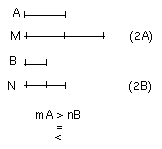If a first magnitude have to a second the same ratio as a third to a fourth, and the third have to the fourth a greater ratio than a fifth has to a sixth, the first will also have to the second a greater ratio than the fifth to the sixth.
 For let a first magnitude A have to a second B the same ratio as a third C has
to a fourth D,
For let a first magnitude A have to a second B the same ratio as a third C has
to a fourth D,
 and let the third C have to the fourth D a greater ratio than a fifth E has to
a sixth
and let the third C have to the fourth D a greater ratio than a fifth E has to
a sixth
 I say that the first A will also have to the second B a greater ratio than the
fifth E to the sixth F.
I say that the first A will also have to the second B a greater ratio than the
fifth E to the sixth F.
 For, since there are some equimultiples of C, E, and of D, F other, chance,
equimultiples, such that the multiple of C is in excess of the multiple of D,
while the multiple of E is not in excess of the multiple of F, [V. Def. 7] let
them be taken,
For, since there are some equimultiples of C, E, and of D, F other, chance,
equimultiples, such that the multiple of C is in excess of the multiple of D,
while the multiple of E is not in excess of the multiple of F, [V. Def. 7] let
them be taken,
 and let G, H be equimultiples of C, E,
and let G, H be equimultiples of C, E,
 and K, L other, chance, equimultiples of D, F,
and K, L other, chance, equimultiples of D, F,
 so that G is in excess of K,
so that G is in excess of K,
 but H is not in excess of L;
but H is not in excess of L;
 and, whatever multiple G is of C, let M be also that multiple of A,
and, whatever multiple G is of C, let M be also that multiple of A,
 and, whatever multiple K is of D, let N be also that multiple of B.
and, whatever multiple K is of D, let N be also that multiple of B.
 Now, since, as A is to B, so is C to D,
Now, since, as A is to B, so is C to D,
 and of A, C equimultiples M, G have
been taken,
and of A, C equimultiples M, G have
been taken,
 and of B, D other, chance, equimultiples N, K,
and of B, D other, chance, equimultiples N, K,
 therefore, if M is in excess of N,
therefore, if M is in excess of N,
 G is also in excess of K, if equal, equal, and if less, less.
G is also in excess of K, if equal, equal, and if less, less.

 But G is in excess of K;
But G is in excess of K;
 therefore M is also in excess of N.
therefore M is also in excess of N.
 But H is not in excess of L;
But H is not in excess of L;
 and M, H are equimultiples of A, E, and N, L other, chance, equimultiples of
B, F;
therefore A has to B a greater ratio than E has to F. [V. Def. 7]
and M, H are equimultiples of A, E, and N, L other, chance, equimultiples of
B, F;
therefore A has to B a greater ratio than E has to F. [V. Def. 7]
Therefore etc.
Q.E.D